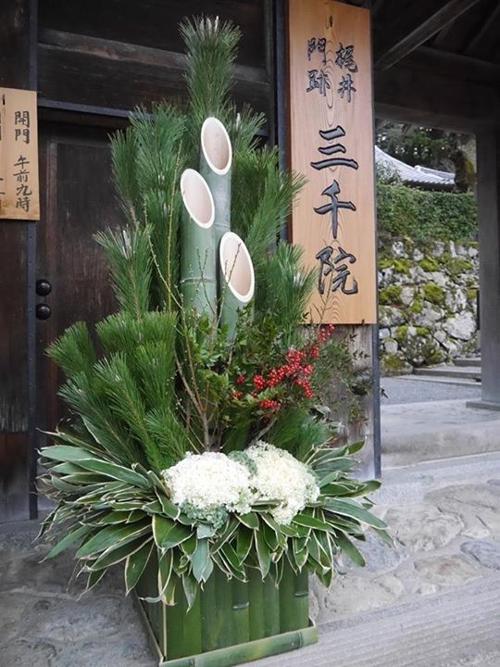New Years and 門松
Happy late New Year (and new decade), everyone! Like with my Christmas in Japan post, I did some research on Japanese New Years and compiled it to share now.

In my Christmas in Japan post, we talked about how American New Years is like Japanese Christmas, and American Christmas is like Japanese New Years. That's because Japan is heavily Shinto/Buddhist, as opposed to Christian.
Many Japanese people tend to follow both Shinto and Buddhist traditions on New Years, maybe going to a shrine the day of and a temple the day after. Large temple bells (除夜の鐘, Joya no Kane) are rung at midnight 108 times, signifying the worldly desires people experience throughout their lives.
On New Year's Eve, many people eat buckwheat noodles. These long soba noodles symbolize longevity.
o-sechiryouri「おせち料理」are traditional Japanese New Year's foods and sweets served in special compartmentalized juubako 「重箱」boxes.
Sending New Year's cards「年賀状」is extremely important in Japan, more so than sending Christmas cards in the west.
What's New Years like in Japan, and what relevance does it have to Japanese culture?

New Years in Japan「日本の正月」
Main Tradition Overview
 |
| A New Year's card from 2020, the year of the rat. I guess a mouse is close enough! |
On New Year's Eve, many people eat buckwheat noodles. These long soba noodles symbolize longevity.
o-sechiryouri「おせち料理」are traditional Japanese New Year's foods and sweets served in special compartmentalized juubako 「重箱」boxes.
Sending New Year's cards「年賀状」is extremely important in Japan, more so than sending Christmas cards in the west.
Kadomatsu
Now that we've got an overview on some of the most important Japanese New Years traditions, I want to focus in on Kadomatsu「門松」. Boasting their own emoji, 🎍, Kadomatsu are traditional decorations made primarily of pine and bamboo. 門松 literally means "gate pine", because they are placed in front of houses and buildings to welcome ancestral spirits or the god of the harvest.
 Kadomatsu are generally made of pine「松, matsu」, Japanese plum 「梅, ume」blossoms, and bamboo「竹, take」tied together with rope. The bamboo symbolizes longevity, with three shoots of differing heights: the tallest representing heaven, the middle representing humanity, and the shortest representing Earth. The pine symbolizes prosperity, and the Japanese plum symbolizes steadfastness.
Kadomatsu are generally made of pine「松, matsu」, Japanese plum 「梅, ume」blossoms, and bamboo「竹, take」tied together with rope. The bamboo symbolizes longevity, with three shoots of differing heights: the tallest representing heaven, the middle representing humanity, and the shortest representing Earth. The pine symbolizes prosperity, and the Japanese plum symbolizes steadfastness.
The ancestors of Kadomatsu started in China in the 7th century, like many Japanese traditions, before moving to Japan in the 8th century. At this point, it was only made of pine-related materials - but in the 14th century, a pine-and-bamboo combination similar to present-day emerged.
Kadomatsu have specifications based on an area's local customs and the size of a house or building. However, generally, one is put on each side of a gate or entrance, signifying both biological genders.
 Kadomatsu and other New Year's decorations are burned in a dondo-yaki 「どんど焼き」festival, generally happening on January 15th. Burning New Year's decorations and Kakizome「書初め, the first calligraphy of the year」along with last year's good luck charms and talismans is said to give thanks as well as welcome in the new year.
Kadomatsu and other New Year's decorations are burned in a dondo-yaki 「どんど焼き」festival, generally happening on January 15th. Burning New Year's decorations and Kakizome「書初め, the first calligraphy of the year」along with last year's good luck charms and talismans is said to give thanks as well as welcome in the new year.
If you'd like to try making your own Kadomatsu, you can start by making an origami one, like I did with the Japanese Culture Club at my school!
 Kadomatsu are generally made of pine「松, matsu」, Japanese plum 「梅, ume」blossoms, and bamboo「竹, take」tied together with rope. The bamboo symbolizes longevity, with three shoots of differing heights: the tallest representing heaven, the middle representing humanity, and the shortest representing Earth. The pine symbolizes prosperity, and the Japanese plum symbolizes steadfastness.
Kadomatsu are generally made of pine「松, matsu」, Japanese plum 「梅, ume」blossoms, and bamboo「竹, take」tied together with rope. The bamboo symbolizes longevity, with three shoots of differing heights: the tallest representing heaven, the middle representing humanity, and the shortest representing Earth. The pine symbolizes prosperity, and the Japanese plum symbolizes steadfastness.The ancestors of Kadomatsu started in China in the 7th century, like many Japanese traditions, before moving to Japan in the 8th century. At this point, it was only made of pine-related materials - but in the 14th century, a pine-and-bamboo combination similar to present-day emerged.
Kadomatsu have specifications based on an area's local customs and the size of a house or building. However, generally, one is put on each side of a gate or entrance, signifying both biological genders.
 Kadomatsu and other New Year's decorations are burned in a dondo-yaki 「どんど焼き」festival, generally happening on January 15th. Burning New Year's decorations and Kakizome「書初め, the first calligraphy of the year」along with last year's good luck charms and talismans is said to give thanks as well as welcome in the new year.
Kadomatsu and other New Year's decorations are burned in a dondo-yaki 「どんど焼き」festival, generally happening on January 15th. Burning New Year's decorations and Kakizome「書初め, the first calligraphy of the year」along with last year's good luck charms and talismans is said to give thanks as well as welcome in the new year.If you'd like to try making your own Kadomatsu, you can start by making an origami one, like I did with the Japanese Culture Club at my school!
Instructions adapted from https://www.youtube.com/watch?v=mzcGAxmFaNE.
Have you ever seen a Kadomatsu? Do you prefer western New Years, with emphasis on partying and celebration, or do you like Japan's religious New Years? Let me know down below!

Comments
Post a Comment